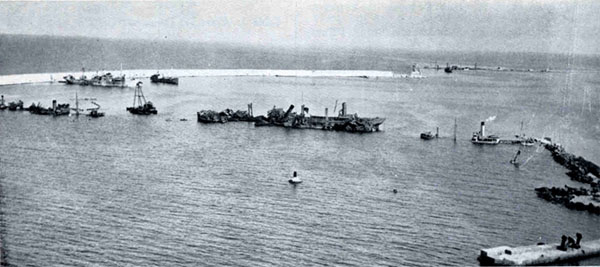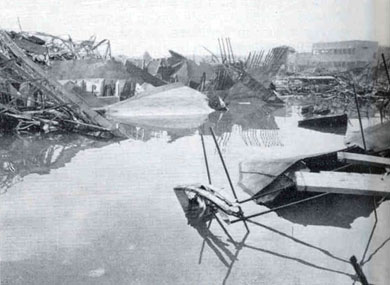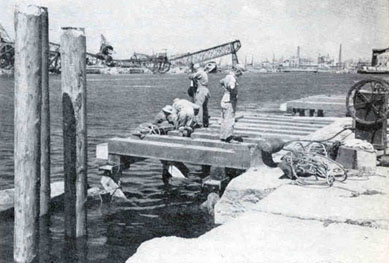Army Engineers Reopened a Key Italian Port in Support of the Allied Advance During World War II
During World War II, the port of Leghorn, on the western coast of Italy, was the most thoroughly demolished port in the Mediterranean. When Fifth U.S. Army captured Leghorn on 19 July 1944, they found it in ruins. The Germans, who occupied the port, had erected barricades, blown bridges, laid mines, and sunk twenty ships to completely seal off the harbor entrances. For their part, in some 50 raids during the first half of 1944, the Allies had dropped more than 1,000 tons of bombs.
 |
| Half-submerged ships blocking entrance to the harbor |
The 338th General Service Regiment got the assignment in early July to rehabilitate the port. They lacked related experience, but no other trained units were available. The 1051st Engineer Port and Repair Group and representatives of the British Navy assisted in planning the operation. Reinforcements came from the 1528th Engineer Dump Truck Company and an Italian Engineer Construction Battalion. The effort employed a heavy complement of Class IV engineer equipment, including fourteen D7 dozers, eight generators, and six 50- or 100-ton barges.
| |
 |
| |
Sunken craft and debris litter the port |
| |
 |
| |
Typical ramp construction at a berth |
| |
Photo source: Military Engineer. Vol. 52. Jan.-Dec. 1960. |
Within hours of the port’s seizure, a dozen members of the 338th had chosen a bivouac site, cleared it of mines, and began to open routes into the central port area. As more elements of the regiment were brought in during the first week, priority shifted to repairing electrical lines and restoring water in addition to mine clearing.
As work progressed, the extent of devastation became clearer. Not only was the port blocked–it took nearly a month to blast through the jam–but the Germans had blown up more than eighty berthing spaces. Ships and small craft, often placed at odd angles to the quays, were sunk everywhere. The enemy also had demolished port equipment and buildings, left craters in roads and railroads, and destroyed all major bridges.
Leghorn was needed as a supply base, so a primary task for engineers was to reconstruct berths for ships. Large quantities of rock were required. The engineers reopened several quarries and in two months trucked in nearly 40,000 tons of crushed rock. While American engineers rebuilt shipping berths, British naval demolition teams continued opening the harbor. Within a month, berths for six Liberty ships had been completed giving Leghorn a capacity of 5,000 tons per day. The goal of 12,000 tons per day was reached by the end of September, as projected.
Roads, bridges, hospitals, depots, and camps received attention as the berths were completed. Every task required extensive minesweeping. Working together with Italian soldiers and civilians, the engineers were able to amass and distribute the large volume of supplies required. Assured of a strong supply base in the rear, Fifth Army moved rapidly forward into the Po River valley.
At Leghorn, the 338th Engineers proved the versatility of World War II general service regiments and demonstrated the critical role played by U.S. Army engineers in supporting units on the move and in restoring key infrastructure.
* * *
April 2003